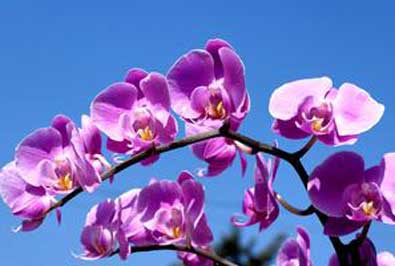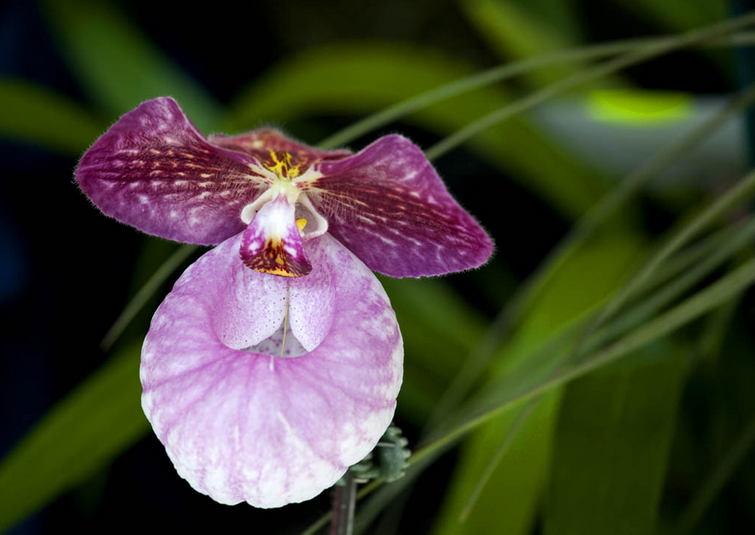How to raise Phalaenopsis in the North
How to raise Phalaenopsis in the north? Phalaenopsis is a single-stemmed aerial orchid, which is originally from the subtropics. It is deeply loved by people because of its beautiful flowers and bright colors. However, because Phalaenopsis has very strict requirements on temperature and humidity, it limits its natural cultivation area, which affects the enthusiasm of orchid lovers, especially tropical orchid lovers in the north. But as long as the method is right, Phalaenopsis can also be planted in the north. Planting Phalaenopsis in the northern region should pay attention to the following problems:
(1) temperature and humidity control. In the growth process of Phalaenopsis, the most stringent conditions are high humidity, suitable temperature and not too strong light. The humidity requirements of Phalaenopsis are shown in the relative humidity requirements. Because it belongs to aerial orchids, the cultivation substrate is required to be loose and aerated, and it cannot contain a lot of water, while part of the roots are exposed. This requires regular spraying of water on the leaves and exposed roots, and spraying a certain amount of water to the surrounding environment to maintain the relative humidity above 85% and 90%.
The suitable temperature for the growth of Phalaenopsis is 1828 ℃. Short time (several hours) or intermittent low temperature (> 8 ℃ but less than 18 ℃) or high temperature (> 28 ℃ but less than 32 ℃) does not cause fatal damage to the growth of Phalaenopsis.
(2) summer management measures. In general, the highest temperature for the normal growth of Phalaenopsis is no more than 28 ℃, so the temperature management is very important in the summer management of Phalaenopsis. Because Phalaenopsis is more shady, it can be placed in a shady place and conditionally placed in an air-conditioned room, but pay attention to air humidity. Because on the one hand, water can meet the needs of plant growth and development, on the other hand, it can reduce the air temperature and adjust the leaf temperature. In summer, the number of water sprays per day should not be less than 4 or 5 times.
(3) winter management measures. Phalaenopsis will stop growing when the temperature is below 18 ℃, when it is below 8. At C, he will die. In the north, Phalaenopsis must be placed in heated or air-conditioned rooms in winter. The specific method is to put the flowerpot on the radiator or windowsill, cover the flowerpot with a data bag, take off the bag every morning, evening or morning, in the middle or evening, and spray water on the leaves and exposed roots, and gently pat the water on the bag in time. This not only maintains a higher temperature, but also maintains a higher humidity, thus ensuring the normal growth of Phalaenopsis. The above is the introduction of how to raise Phalaenopsis in the north.
How to raise Phalaenopsis in the North
Among tropical orchids, Phalaenopsis is relatively easy to cultivate successfully. Even in the north of our country, Phalaenopsis can be cultivated well as long as we create a warm and cozy environment with high air temperature. So, how do you grow Phalaenopsis in the north? Now let us tell you how to grow Phalaenopsis in the north.

How to raise Phalaenopsis in the north?
Selection of basin
The key to raising orchids lies in Qi. Generally, a plain fired pottery basin or tile basin should be chosen, and a porous shallow basin is better, so as to increase air permeability and water permeability, that is, the basin height is preferably less than the basin diameter.
Selection of culture medium:
Phalaenopsis is a typical epiphytic orchid, and its root system is well developed. the cultivation substrate must have the characteristics of looseness, ventilation, good air permeability and rot resistance. Pine needles, peanut shells and bark shreds should be selected as substrates.
Temperature:
The first thing to keep Phalaenopsis at home is to keep the temperature. Phalaenopsis likes the environment of high temperature and high humidity. The lowest temperature during the growth period should be kept above 15 ℃. The suitable temperature for Phalaenopsis growth is 16 ℃ to 30 ℃.
Watering:
Phalaenopsis is native to the primeval forest with more fog and higher temperature. Phalaenopsis does not have thick pseudobulbs to store nutrients, and if there is not enough temperature in the air, the leaves are wrinkled and weak. Therefore, Phalaenopsis should be cultivated and maintained in an environment with high ventilation and humidity.
Lighting:
Although Phalaenopsis prefers shade, it is still necessary to make the orchid plant accept some light, especially before and after flowering, the appropriate light can promote Phalaenopsis to blossom and make the flowers gorgeous and long-lasting, generally should be placed indoors where there is scattered light, do not let direct sunlight.
Nutrition:
Phalaenopsis should be fertilized all year round. Unless the low temperature lasts for a long time, fertilizer should not be stopped. Thin fertilizer should be applied frequently.
Post-anthesis management: the florescence is generally around the Spring Festival, and the viewing period can be as long as 2 to 3 months. When the flowers wither, the withered flowers should be cut off as soon as possible, which can reduce the consumption of nutrients.
Culture methods of Phalaenopsis
1. Phalaenopsis's requirements for soil Phalaenopsis is a kind of soil that likes moss and aquatic plants, so the soil will be very soft and breathable.
two。 Phalaenopsis temperature requirements Phalaenopsis is a kind of temperature requirements are very high, the growth temperature is 15-30 degrees in the environment, if the temperature is lower than this temperature, or higher than this temperature, Phalaenopsis will not grow, there is also the phenomenon of yellow leaves.
3. Phalaenopsis for moisture requirements Phalaenopsis requires enough water, because the leaves of Phalaenopsis are not easy to store moisture, so the soil of Phalaenopsis must have enough moisture. More water can be drenched during the peak growth period, and less water should be drenched in the dormant period of Phalaenopsis. In summer, you can get wet once in the morning and once in the afternoon, while in winter, you can get wet once a week.
4. The requirement of Phalaenopsis for light Phalaenopsis is a kind of light-loving plant, especially in flowering plants, which should also be shaded by the sun in summer. At the same time, it is best to keep Phalaenopsis in a ventilated place. Only in this way can the occurrence of diseases and insect pests be reduced.
How to raise Phalaenopsis after flowering
Some netizens asked how to raise Phalaenopsis and how to raise Phalaenopsis after flowering. Below, the author will answer your questions about how to raise Phalaenopsis. I hope it will be helpful for you to raise Phalaenopsis. Phalaenopsis is becoming more and more popular with consumers because of its colorful shape resembling butterflies. Especially when giving it to relatives and friends on holidays, we all like it very much, but we all like it, and we all think that Phalaenopsis is not easy to raise. A friend often told me that the Phalaenopsis raised at home died in a few days.
Here today to teach a few tips on how to maintain Phalaenopsis, in order to maintain Phalaenopsis, you must first choose good potted materials. You see, there are two kinds of materials here, this one is the matrix, and the other one is fluffy aquatic plants. Which of these two materials is more suitable for the conservation of Phalaenopsis? Let's listen to-listen to what the experts say.
Interviewer: the best is this kind of water moss, because its water seepage is the best. From the aspect of growing Phalaenopsis, look at its displacement. After pouring water into it, it discharges no water at all. However, the moisture needed by Phalaenopsis is firmly locked, and the bark and so on, so you have all seeped down after watering, and it has not retained any water. I suggest that Phalaenopsis should be raised with this kind of water moss (aquatic plants). Now we already know that aquatic plants are the most suitable potted material for growing Phalaenopsis. So why do so many friends still raise Phalaenopsis at home?
I don't think he-must have noticed the environment in the family. Phalaenopsis has very strict requirements for temperature and humidity. The most suitable temperature is 10 degrees Celsius to 30 degrees Celsius, and the most suitable humidity is 50% to 60%. If you think it's too professional to calculate,
In addition, you can buy a dry and wet thermometer like this. You see, this side can be the indoor temperature, and this side is the indoor humidity, so you can see the indoor temperature and humidity.
And in winter, there are heating facilities in the north, so it is easy to reach the temperature needed by Phalaenopsis. Because the indoor temperature of the heating facility has reached in winter, but its temperature is relatively less. How to maintain the humidity of Phalaenopsis, I can tell you two tips: first, we can hit a basin of clear water and put it here. If you don't think it looks good, there is another way. You can wet it with a towel. Then put this towel on the Phalaenopsis basin so that you can and increase the humidity of Phalaenopsis. And the most important thing is never put Phalaenopsis on the heating facility or blow under the air conditioner, because the wind is very dry.
- Prev

How to cultivate Phalaenopsis
How to cultivate Phalaenopsis, Phalaenopsis is a perennial epiphytic herbaceous flower of Phalaenopsis of Orchidaceae, which is native to tropical Asia, has neither stolon nor pseudobulb, and has poor adaptability to climate. The stem is short, about 5 to 8 centimeters long, and each plant has only a few thick leaves stacked alternately at the base of the stem.
- Next

How to raise Aristolochia
How to raise Aristolochia? Aristolochia is native to tropical Asia, with peculiar flower pattern and long flowering period. it is usually divided into two types according to its growth form: one is native to alpine cool areas, with all-green leaves, large and colorful flowers, cold and cold sex, summer dormancy, and flat land is not easy to cultivate; the other kind of leaves are striped, warm and damp.
Related
- Fuxing push coffee new agricultural production and marketing class: lack of small-scale processing plants
- Jujube rice field leisure farm deep ploughing Yilan for five years to create a space for organic food and play
- Nongyu Farm-A trial of organic papaya for brave women with advanced technology
- Four points for attention in the prevention and control of diseases and insect pests of edible fungi
- How to add nutrient solution to Edible Fungi
- Is there any good way to control edible fungus mites?
- Open Inoculation Technology of Edible Fungi
- Is there any clever way to use fertilizer for edible fungus in winter?
- What agents are used to kill the pathogens of edible fungi in the mushroom shed?
- Rapid drying of Edible Fungi

